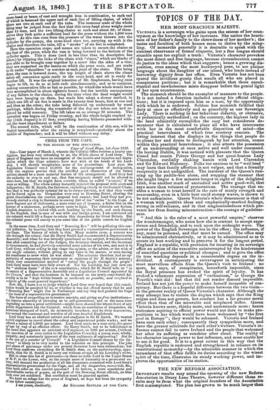THE BRITANNIA BRIDGE: PROGRESS OF THE WORKS. [Although the Britannia
Bridge for railway traffic across the Menai Strait does not yet hang in mid air, there has been no real delay in the process of raising it. On the contrary, while the process adopted is somewhat slower than that originally contemplated, it is one that takes an efficient gua- rantee against calamity. The published accounts are for the most part very confusecl and inaccurate; but our readers will be able to understand what is going forward from the account with which we have been favoured by a scientific correspondent.] The tube, by the operation of floating, (described in the Spectator of the 23d June,) was left resting at the foot of the towers, each end being there supported on a shelf of stone so that at the highest state of the tide there was a space of about three feet between its bottom and the water. Here, until last Friday, it remained while the preparations were making in the upper part of the towers for raising it through the 100 feet necessary to attain the " 103 feet above high-water spring-tides" demanded by the Admiralty, both in this case and in that of the Menai Bridge.
These preparations consist of an hydraulic press of immense power in each tower, with the steam-engine and pumps necessary for the working of each; and of the lifting-chains which hang down from the presses and take hold of the recumbent tube below. These chains had to be put to- gether on the top of the tube, and then got op from thence into their de- pendent position. They do not consist of short links one within the other, like a common chain, but are like those of a suspension-bridge, the links being six feet long.
The hydraulic press is placed in the highest part of the tower, so as to be clear above the tube when lifted into its ultimate position. It consists of a close cylinder of great strength, with a ram or solid piston working through a water-tight collar in the top: the ram bearing across its top a cross-head or beam of cast and wrought iron in combination, to each end of which is fastened the upper end of each line of lifting chains, of which there are two at each end of the tube. The immense scale of the whole thing may be judged from the fact that this cross-head alone weighs more than 15 tons, and the two lifting-chains at each end about 50; of them- selves they look quite a sufficient load for the press without the 1,800 toot below. As this ram rises from the pressure of the water thrown into the 'cylinder by the pumps, the cross-head rises too carrying up with it the chains and therefore the tube, till a " stroke " of six feet is completed. Here the operation stops-' and means are taken to secure the chains at the foot of the press, while the ram is being lowered to the bottom of the cylinder again. This is done (and in less time than its description has taken) by clipping the links of the chain with "clams," which are blocks of iron able to be brought near together by a screw like the sides of a vice; they are supported on the beams on which the press rests, and are made to fit under ` shoulders" or notches at each joint of the chain. This being done, the ram is lowered down, the top length of chain above the clams taken off, connexion again made to the cross-head, and all is ready for another lift. It was the original intention of Mr. Stephenson, having once begun to lift, to do so at both ends simultaneously, and so to continue, reakiug consecutive lifts as fast as possible, by which the whole would have been accomplished in about eighteen hours: but the terrible consequences of any failure in the chains, during the time when the dead weight would have been hanging on them, has made him adopt a slower method, in which one lift of six feet is made in the twenty-four hours, first at one end and then at the other; the tube being followed up underneath by wood packing'', which during the remainder of the day are taken out and re- placed by solid masonry. The lift takes on an average 38 minutes. The operation was begun on Friday evening, and the whole height reached to- day (16th August) is 27 feet; everything having hitherto proceeded with- out the least impediment or failure.
The second tube, which will be the continuation of this ono, will be floated immediately after the raising is completed—probably about the middle of September; and it will be lifted without any delay.



























 Previous page
Previous page